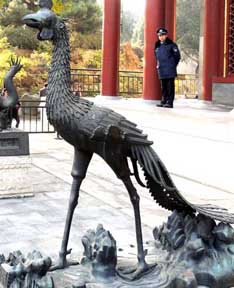
China - Table of Contents .........Chinese Architecture Dictionary.............Illustrated Architecture Dictionary .

China - Table of Contents .........Chinese Architecture Dictionary.............Illustrated Architecture Dictionary .
Classical Chinese Phoenix (Feng-huang)


| Said
to rule over the southern quadrant of the Heavens in Chinese myth. It
is also called the “Emperor of all birds” and symbolizes warmth, peace,
and prosperity. It is only supposed to appear during the reign of a
virtuous ruler, after being summoned by a musical instrument called the
shao. Buddhists consider the phoenix a sacred bird, since it is not a flesh-eating predator. While the phoenix is often mentioned in myth, scholars cannot decide whether the bird was meant to refer to a real bird, and, if so, which one. Some think it was actually a peacock or an argus pheasant; artists have represented it as both. The bird is sometimes identified as the Red Bird. In some Egyptian myths, the phoenix is said to rise from its own ashes after a fiery death. This idea is not present in Chinese myth. |
|
As the dragon became the
symbol of the emperor, the Feng-huang (which the West likes to call the
Phoenix; goodness knows why) became the symbol of the empress. It was
considered to be the ruler of the birds, corresponding to the dragon
being the king of animals.
It was said that the song of the phoenix is exceptionally beautiful and meaningful and that the animal had a special appreciation of human music. Like the dragon, its form was complex, and it was endowed with spectacular elements. In the 1st or 2nd century AD it was described as having the breast of a goose, the hindquarters of a stag, the neck of a snake, the tail of a fish, the forehead of a fowl, the down of a duck, the marks of a dragon, the back of a tortoise, the face of a swallow, and the beak of a cockerel. The feng-huang was always subordinate to the dragon, just as the empress was subordinate to the emperor. - Roy Bates, The Forbidden City - A Brief Introduction (online Jan. 2014)
|
Examples:
- Top illustration above: Summer Palace, Beijing
- Lower illustration above: Temple of Heaven, Beijing
- Forbidden City, Beijing
